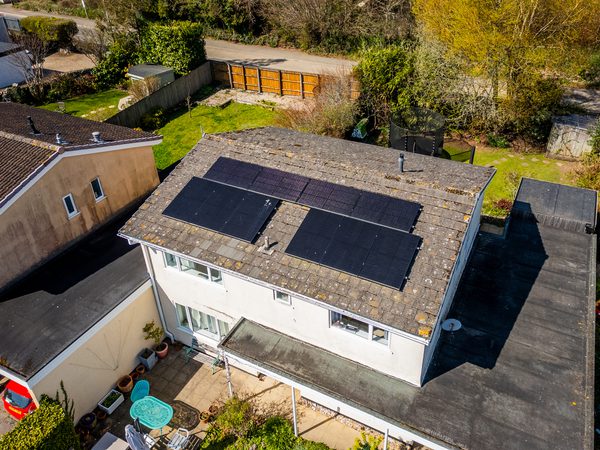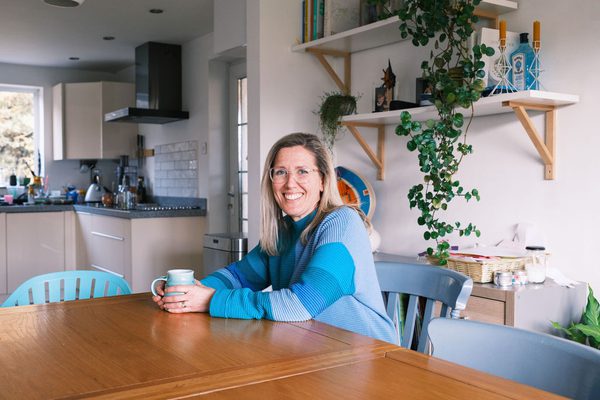- Future Fit /
- Testimonials /
- Climate conscious choices: Teresa's home energy transformation
Climate conscious choices: Teresa's home energy transformation

"‘We were very conscious about climate change and our carbon footprint."
When Teresa and her family moved into their 1970s four-bedroom detached house in Yealmpton in south Devon, it was already in good condition.
Unlike many retrofit stories, there were no pressing issues with damp, cold, or excessive energy bills. Instead, their motivation came from a concern for their environmental impact and a desire to create a more sustainable home.
Good to great: improving an already solid home
Teresa's house was typical of many 1970s properties – reasonably comfortable but with significant room for improvement in energy efficiency.
"It didn't feel particularly cold or damp... It was definitely quite a good house to start with – we just wanted to make it even better. We wanted to do something to make the house more energy efficient."
With both Teresa and her partner working from home, they use energy throughout the day, making efficiency improvements even more impactful for both their carbon footprint and their energy bills.
The first steps: expertise and funding
Teresa's journey began with an energy advice visit from her local community energy organisation. The advisor conducted an assessment of her home and installed some simple measures like radiator reflectors straight away.
Importantly, they identified that Teresa's family was eligible for grant funding for cavity wall insulation because they had a child under five in the household. The community energy organisation arranged for this work to be carried out by a regional installer, who also installed additional ventilation to ensure the newly-insulated home would remain healthy.
Following the recommendations from their energy assessment, Teresa then moved forward with installing solar panels:
"We approached a solar panel installer, they came and gave us a quote, and we just went for it, really. We had a separate electrician that came and did the car charger."

Smart financing for long-term benefits
Rather than paying upfront for the solar panels and EV charger, Teresa used a loan through Lendology CIC, a specialist provider of home improvement loans for renewable energy.
“We didn't have to pay anything upfront. I think we took out a loan over four years, with very low interest rates. It was just really straightforward – just email exchanges really and some contracts to sign.”
This financing approach made the improvements immediately accessible while spreading the cost. Interestingly, Teresa made this investment despite knowing they might not stay in the property forever.
"We knew actually, even at the time, that we might not even stay at the property forever. We just felt like it was the right thing to do to get solar panels up there."
Transforming energy use habits

The combination of cavity wall insulation, solar panels, and an electric vehicle charger has changed how Teresa's family uses energy in their home.
“With all the extra insulation, you definitely notice the difference straight away in terms of it being much warmer and the gas bill going down. It retains its heat a bit better as well."
Their approach to electricity use has evolved too, particularly after switching to Octopus Energy's special EV tariff:
"Originally, when we first got the solar panels, everything would go on in the day when we were here to take advantage of the solar generation. With the new tariff, we've changed our habits, putting on the washing machine and dishwasher on timer overnight for example, and charging the car overnight."
These changes have been supported by simple technology – plug-in timers controlled via smartphone apps – allowing the family to benefit from cheaper overnight rates while exporting solar electricity to the grid during the day at a higher rate.
"It feels really good. It's nice that you're using the renewable energy in the night that wouldn't otherwise be being used. And then in the day, you can use the solar that's been generated right here on our own roof."
Financial benefits that make sense

The financial case for Teresa's retrofit has been compelling, especially when considered alongside their switch to an electric vehicle:
"We used to pay about £200 a month on our diesel bills for our car, but the electric car is so much cheaper to run.
The cost of the loan payments is actually covered by the savings in fuel. So we sort of don't really notice paying the difference in our bank account."
A legacy of green energy efficiency
Now that Teresa is selling the property, she reflects on the value of the improvements they've made:
"The solar initially attracted interest from buyers. And it’s rewarding to pass on a legacy of energy efficiency to whoever buys the house. I’m pleased these improvements will continue benefiting both the new owners and the environment long after we’ve moved on."
The new owners of Teresa’s home will benefit from a home that's dramatically more efficient than when Teresa's family moved in, with an EPC rating that has improved from a D to a high B (87).